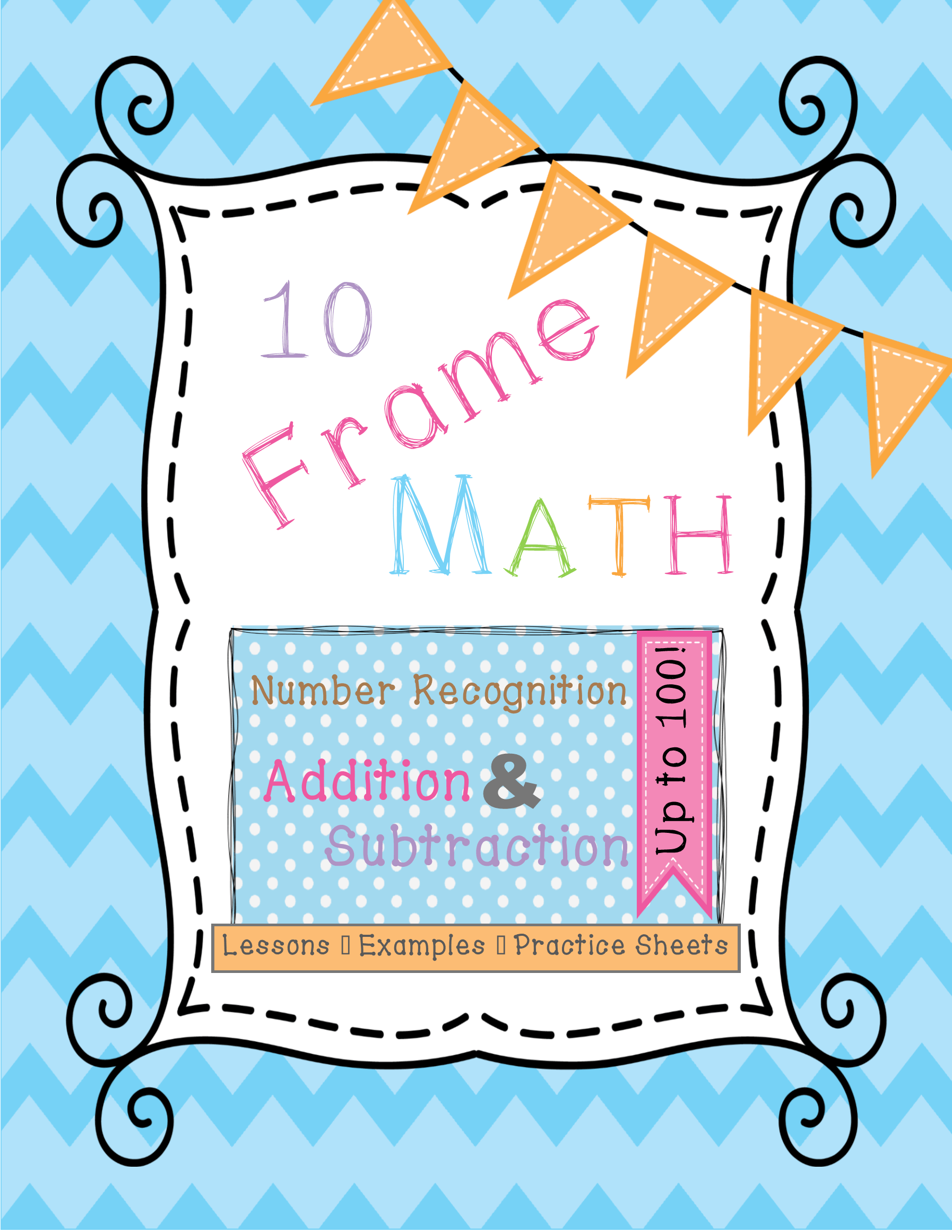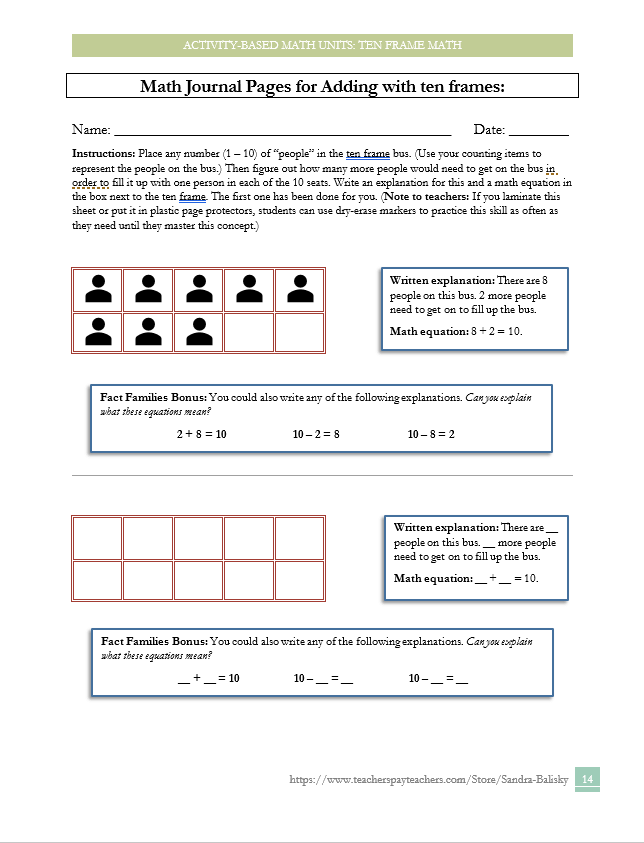Developing number sense and mathematical reasoning using ten frames
This is our story about using ten frames with seashells — and the resulting 28 page activity-based lesson pack I created, with a free printable!
The original inspiration:

I’ll randomly do some ten frame math activities with N (now 4 y.o.). We’ve used egg cartons, sketches on paper, “official” ten frame plastic trains, and now a large plastic floor mat with seashells and expo markers.
I was a math teacher for several years, so sometimes it’s a bit hard to contain my excitement about numbers and patterns and logic and anything else that’s even tangentially math related. (ha! pun intended.)
The basic idea of a ten frame is that you provide a visual representation of numbers based on groups of 10. (An abacus is also a great way to do this ~ I’m looking forward to doing more with that later.) There are five spaces on top and bottom, which is a small enough amount for kids to tell at a glance how many objects there are without counting.
There are a ton of activities you can do with these; I’ll describe a few here and link to more posts later describing some of our other ten frame games.
Recognizing (and building) numbers 1 – 20

At first we practiced filling up the spaces with shells and counting them until N got familiar enough with the visual that he could tell me at a glance how many shells there were (for numbers 1 – 10). Then I filled up the first one with 10 shells and put a few shells in the next ten frame so he could see that for numbers greater than 10, you don’t have to start counting from 1 every time — you know there’s already 10, so you can just add on. Here’s our visual of the number 14, which is clearly, from the diagram, 10 + 4.
Adding numbers
Then I extended the idea to include adding two numbers that were each less than 10. For example, I set 5 shells in the top ten frame and 7 in the bottom one. Then he would take shells out of the bottom one to fill up missing spaces in the top one. So 5 + 7 became 10 + 2, since the 7 shells were used to fill up the 5 empty spaces and there were 2 left over. Then we went back to the previous idea of counting on from a full ten-frame to find out that there were 12 altogether.


Patterns in doubles
I took it a step further to practice adding doubles and I wanted to see if he would notice any patterns. (The pattern part was way beyond him; we’ll revisit that in a few years!) We didn’t make it through all the doubles (attention span with a (then) 3 year old is limited!) but he did re-arrange several the way I just described and counted to find the total amount. We kept a running list at the bottom. (apologies for the low quality pictures … The light reflections and my own ignorance about taking pictures were conspiring against me!)

That was as far as we got for the day. I’ll post other ten frame activities in future Math Monday articles.
Free Printable
I later went back and created a free printable ten frame math game and a 28 page parent guide with interactive activities for kids based on these activities.

Based on some further games and activities we made up using ten frames, I designed this mini activity pack as a free download to help encourage kids to enjoy playing math games. These simple activities help to develop a strong foundation in number sense. You can download it for free here by clicking on the link above (or from the Freebies tab in the menu).
I also spend several weeks designing a complete unit based on ten frames that takes students from beginning math (counting and understanding numbers) through adding and subtracting double digit numbers. (This one is not free though ;).)
Download your own complete Ten-Frame Activity Pack
You can see the product and full detail here.
Overview of the Ten-Frame Unit:
 This unit is made of 4 lessons. Each lesson includes full explanations for teachers and activities for students including printable journal pages for practice and learning games; the entire unit is designed to help foster number sense, mathematical communication, and discovery-based learning.
This unit is made of 4 lessons. Each lesson includes full explanations for teachers and activities for students including printable journal pages for practice and learning games; the entire unit is designed to help foster number sense, mathematical communication, and discovery-based learning.
Lesson 1 begins with number recognition from 1 – 10 focusing on building numbers in groups of 5. It then moves up to recognizing and building numbers up through 20.
Lesson 2 focuses on addition up through 20 with an emphasis on combinations of numbers that add to 10 and their associated fact families.
Lesson 3 goes on to more complex addition (up through 100) and teaches students to break numbers up into groups of 10’s and 5’s and re-arrange as needed to come up with the answer. The strategies explained here help to build a strong conceptual understanding of addition rather than emphasizing an algorithm (set of steps to follow).
Lesson 4 teaches students to subtract numbers (up through 100) by visualizing them in groups of 10’s (with sub-groups of 5’s).
Brief introduction to ten frames:
 Since our number system is built around groups of 10, it is essential for kids to learn from a young age how to identify and manipulate numbers within our base 10 system.
Since our number system is built around groups of 10, it is essential for kids to learn from a young age how to identify and manipulate numbers within our base 10 system.
To provide a strong foundation for fluency in the language of numbers, students should be introduced first to visual representations of numbers. If they can recognize amounts at a glance based on groupings of 5’s and 10’s, this will pave a strong foundation for them to become comfortable and confident working with numbers. Once they can comfortably understand and explain how all single digit numbers relate to 10, it’s a simple matter to start adding or subtracting double digit numbers by re-arranging numbers into 10’s, 5’s, and 1’s.
Ten frame activities are a great way to introduce these topics. The activities in this lesson pack describe fun (and unconventional!) ways to use ten frames. You can purchase ten frames sold as sets with counting items, or you can simply draw ten frames on paper and use items you have around the house as the objects for counting (rocks, cheerios, marbles, legos, macaroni pieces, beads, etc.). I’ve also used an empty egg carton as a ten frame container after cutting it down to size.
 For those of you who are familiar with base-10 blocks, some of these activities may look familiar. Although the same basic idea applies to base-10 blocks, the added value of breaking groups of 10 into sub-groups of 5’s makes this a viable strategy for mental math, even with large numbers. Students can instantly imagine “glance-able” amounts of objects, break apart and re-arrange numbers, and recombine the “leftovers” to figure out the final answer. And again, since amounts of objects up to 5 can be known at a glance, without counting, and since all numbers can be broken up into 10’s and 1’s (bigger numbers into 100’s and 10’s and 1’s, etc.), students can take this one step further (instantly, in their head) to see numbers as combinations of 5’s within groups of 10’s and solve larger addition or subtraction problems.
For those of you who are familiar with base-10 blocks, some of these activities may look familiar. Although the same basic idea applies to base-10 blocks, the added value of breaking groups of 10 into sub-groups of 5’s makes this a viable strategy for mental math, even with large numbers. Students can instantly imagine “glance-able” amounts of objects, break apart and re-arrange numbers, and recombine the “leftovers” to figure out the final answer. And again, since amounts of objects up to 5 can be known at a glance, without counting, and since all numbers can be broken up into 10’s and 1’s (bigger numbers into 100’s and 10’s and 1’s, etc.), students can take this one step further (instantly, in their head) to see numbers as combinations of 5’s within groups of 10’s and solve larger addition or subtraction problems.
 Although the process explained in the following lessons may look elaborate and lengthy, once students have solidly grasped these foundational concepts they will be able to do higher level math problems nearly instantly in their heads. Learning math in this way will help them become confident and happy learners. The steps explained in this lesson pack are designed to lead children at their own pace to a solid understanding of the number system; each step builds on previous concepts so that children can extend ideas they’ve mastered to new situations without ever being forced into frightening new territory where they find themselves ill-equipped to answer questions.
Although the process explained in the following lessons may look elaborate and lengthy, once students have solidly grasped these foundational concepts they will be able to do higher level math problems nearly instantly in their heads. Learning math in this way will help them become confident and happy learners. The steps explained in this lesson pack are designed to lead children at their own pace to a solid understanding of the number system; each step builds on previous concepts so that children can extend ideas they’ve mastered to new situations without ever being forced into frightening new territory where they find themselves ill-equipped to answer questions.
Note: If you learned certain patterns of steps (an algorithm) for adding or subtracting large numbers and if you understood why those steps worked and you got pretty good at it, you may be able to do all the exercises mentioned here more quickly using your method than the method I will describe. Don’t let that deter you, however, from teaching your students how to count, add, and subtract using ten frames. Think of it as a language; if this is a second language for you, it may not be the fastest way for you to speak or think, but if you can teach your children this language of math from the beginning, it will become their default language and they will think of numbers in groups of 10’s that can be re-arranged as needed to help solve almost any problem.
This method is best when taught to young students who are just encountering the number system, because it presents numbers in an organized, mentally “re-arrangeable” way that will help them intuitively understand how addition and subtraction with large numbers works.
If older students have tried to learn certain algorithms but become frustrated because they don’t understand why a certain process works, or they can’t remember all the steps needed for things like re-grouping or borrowing, this method can be used to help them go back to the basics and lay a solid foundation. Then, based on a stronger sense of how numbers and operations work, they can advance quickly to more complex topics
Click here to get your copy and to see several free and less-than-a-dollar math journal activity pages. I hope these resources help your kids enjoy learning math!
Other Math Monday posts:
- Cotton Ball Algebra
- Sticker Bar Graphs
- Tessellations
- RightStart curriculum
- Exponential Growth (for kids)
Teaching and Learning Products
To see my series of activity-based lesson packs and other learning resources (Pre-K – 12th grade), visit my store at: https://www.teacherspayteachers.com/Store/Sandra-Balisky

15 comments on “Math Monday: Ten frame math with seashells”